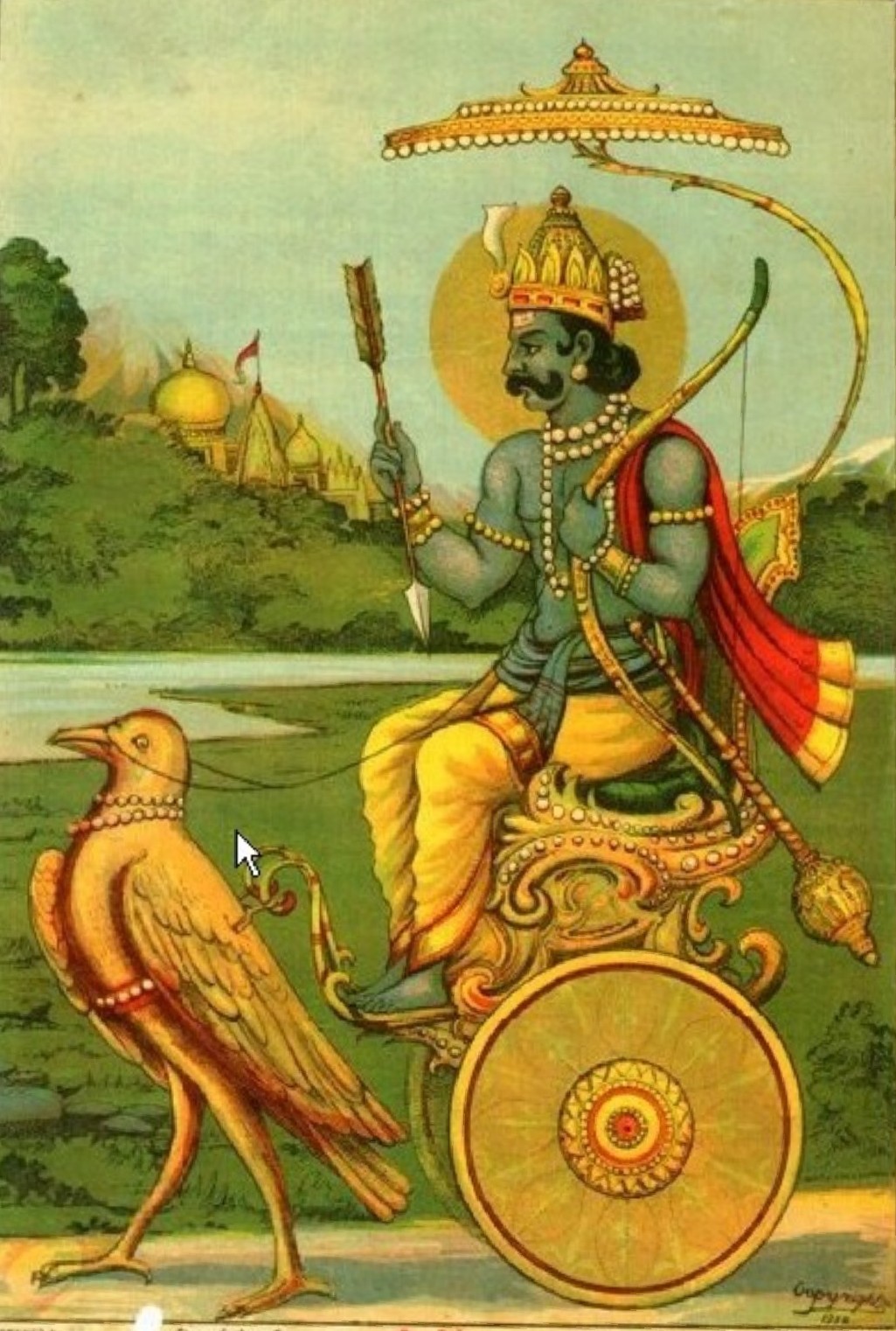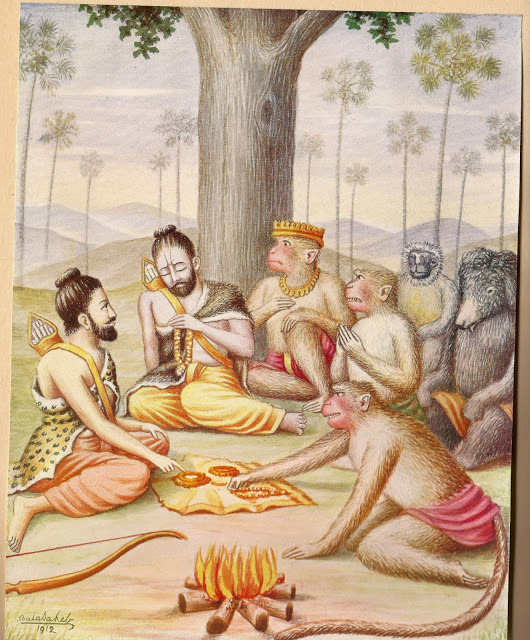|
┼øani
Shani (, ), or Shanaishchara (, ), is the divine personification of the planet Saturn in Hinduism, and is one of the nine heavenly objects (Navagraha) in Hindu astrology. Shani is also a male Hindu deity in the Puranas, whose iconography consists of a figure with a dark complexion carrying a sword or danda (sceptre) and sitting on a buffalo or some times on a crow. He is the god of ''karma'', justice, time and retribution, and delivers results depending upon one's thoughts, speech, and deeds. Shani is the controller of longevity, misery, sorrow, old age, discipline, restriction, responsibility, delays, ambition, leadership, authority, humility, integrity, and wisdom born of experience. He also signifies spiritual asceticism, penance, discipline, and conscientious work. He is associated with two consorts: Neela, the personification of the gemstone sapphire, and Manda, a gandharva princess. Planet ''Shani'' as a planet appears in various Hindu astronomical texts in Sanskrit, s ... [...More Info...] [...Related Items...] OR: [Wikipedia] [Google] [Baidu] |
Navagraha
The navagraha are nine heavenly bodies and deities that influence human life on Earth according to Hinduism and Hindu mythology. The term is derived from ''nava'' ( "nine") and ''graha'' ( "planet, seizing, laying hold of, holding"). The nine parts of the navagraha are the Sun, Moon, planets Mercury, Venus, Mars, Jupiter, and Saturn, and the lunar node, two nodes of the Moon. The term ''planet'' was applied originally only to the five planets known (i.e., visible to the naked eye) and excluded the Earth. The term was later generalized, particularly during the Post-classical history, Middle Ages, to include the sun and the moon (sometimes referred to as "lights"), making a total of seven planets. The Seven days of the week#Hindu tradition, seven days of the week of the Hindu calendar also corresponds with the seven classical planets and European culture also following same patron and are Names of the days of the week#Hindu tradition, named accordingly in most languages of the India ... [...More Info...] [...Related Items...] OR: [Wikipedia] [Google] [Baidu] |
Savarni Manu
Savarni Manu () is the eighth Manu, the first man of an age known as the Manvantara in Hindu mythology. Literature The Vishnu Purana specifies fourteen Manus. The Manu of the present age is called Vaivasvata Manu, the seventh man to hold the title. He is to be succeeded by his half-brother Sarvabhauma, who would be called the Savarani Manu. The eighth Manu is described to be born to Surya, the god of the sun, and Chhaya, one of his consorts. The authorship of the Brahma Vaivarta Purana is attributed to this Manu, who narrates its contents to Narada. According to the Srimad Bhagavatam, Savarni's sons are stated to be Nirmoka, Virojaksha, and unnamed others. During his reign, the deities of Surya and Vishnu are stated to be venerated. Bali, the son of Virochana, is described to rule as king. Galava, Diptiman, Ashvatthama, Kripa, Rishyashringa, Vadrayana, and Parashurama Parashurama (), also referred to as Rama Jamadagnya, Rama Bhargava and Virarama, is the sixth ava ... [...More Info...] [...Related Items...] OR: [Wikipedia] [Google] [Baidu] |
Brahma Vaivarta Purana
The ''Brahmavaivarta Purana'' (; ) is a voluminous Sanskrit text and one of the major Puranas (''Maha-purana'') of Hinduism. It is an important Vaishnava text. This Purana majorly centers around the Hindu deities Radha and Krishna. Although a version may have existed in late 1st millennium CE, its extant version was likely composed in the Bengal region of Indian subcontinent in 15th-16th century. Later, it was likely revised somewhere in South India. Numerous versions of this Purana exist and are claimed to be the part of manuscripts of the ''Brahmavaivarta Purana'' or the ''Brahmakaivarta Purana''. The text is notable for identifying Krishna as the supreme reality and asserting that all gods such as Vishnu, Shiva, Brahma, Ganesha are one and the same and in fact, all are the incarnations of Krishna. Goddesses like Radha, Durga, Lakshmi, Saraswati and Savitri are asserted to be equivalent and are mentioned as the incarnations of Prakruti in this text, with legends similar ... [...More Info...] [...Related Items...] OR: [Wikipedia] [Google] [Baidu] |
Satre (Etruscan God)
Satre or Satres was an Etruscan god who appears on the Liver of Piacenza, a bronze model used for haruspicy. He occupies the dark and negative northwest region, and seems to be a "frightening and dangerous god who hurls his lightning from his abode deep in the earth." It is possible that Satre is also referred to with the word "" in the '' Liber Linteus'' ("Linen Book," IX.3), the Etruscan text preserved in Ptolemaic Egypt as mummy wrappings. Satre is usually identified with the Roman god Saturn, who in a description by Martianus Capella Martianus Minneus Felix Capella () was a jurist, polymath and Latin literature, Latin prose writer of late antiquity, one of the earliest developers of the system of the seven liberal arts that structured early medieval education. He was a native ... holds a position similar to that of Satre on the liver. The name ''Satre'' may be only an Etruscan translation of ''Saturnus'', or ''Saturnus'' may derive from the Etruscan; it is also possible t ... [...More Info...] [...Related Items...] OR: [Wikipedia] [Google] [Baidu] |
Nj├Čr├░r
In Norse mythology, Nj├Čr├░r (Old Norse: ) is a god among the Vanir. Nj├Čr├░r, father of the deities Freyr and Freyja by Sister-wife of Nj├Čr├░r, his unnamed sister, was in an ill-fated marriage with the goddess Ska├░i, lives in N├│at├║n (mythology), N├│at├║n and is associated with the sea, seafaring, wind, fishing, wealth, and crop fertility. Nj├Čr├░r is attested in the ''Poetic Edda'', compiled in the 13th century from earlier traditional sources, the ''Prose Edda'', written in the 13th century by Snorri Sturluson, in euhemerized form as a beloved mythological early king of Sweden in ''Heimskringla'', also written by Snorri Sturluson in the 13th century, as one of three gods invoked in the 14th century ''Hauksb├│k'' Alm├Īttki ├Īss, ring oath, and in numerous Scandinavian toponymy, place names. Veneration of Nj├Čr├░r survived into the 18th or 19th century Norway, Norwegian folk practice, where the god is recorded as Njor and thanked for a bountiful catch of fish. Nj├Čr├░r has ... [...More Info...] [...Related Items...] OR: [Wikipedia] [Google] [Baidu] |
Saturn (mythology)
Saturn ( ) was a god in Religion in ancient Rome, ancient Roman religion, and a character in Roman mythology. He was described as a god of time, generation, dissolution, abundance, wealth, agriculture, periodic renewal and liberation. Saturn's mythological reign was depicted as a Golden Age of abundance and peace. After the Roman conquest of Greece, he was conflated with the Greek Titan Cronus. Saturn's consort was his sister Ops, with whom he fathered Jupiter (mythology), Jupiter, Neptune (mythology), Neptune, Pluto (mythology), Pluto, Juno (mythology), Juno, Ceres (Roman mythology), Ceres and Vesta (mythology), Vesta. Saturn was especially celebrated during the festival of Saturnalia each December, perhaps the most famous of the Roman festivals, a time of feasting, role reversals, free speech, gift-giving and revelry. The Temple of Saturn in the Forum Romanum, Roman Forum housed the state treasury and archives (''aerarium'') of the Roman Republic and the early Roman Empire. The ... [...More Info...] [...Related Items...] OR: [Wikipedia] [Google] [Baidu] |
Cronus
In ancient Greek religion and Greek mythology, mythology, Cronus, Cronos, or Kronos ( or ; ) was the leader and youngest of the Titans, the children of Gaia (Earth) and Uranus (mythology), Uranus (Sky). He overthrew his father and ruled during the mythological Golden Age until he was overthrown by his son Zeus and imprisoned in Tartarus. According to Plato, however, the deities Phorcys, Cronus, and Rhea (mythology), Rhea were the eldest children of Oceanus and Tethys (mythology), Tethys. Cronus was usually depicted with a harpe, scythe, or sickle, which was the instrument he used to castrate and depose Uranus, his father. In Athens, on the twelfth day of the Attic month of Attic calendar, Hekatombaion, a festival called Kronia was held in honour of Cronus to celebrate the harvest, suggesting that, as a result of his association with the virtuous Golden Age, Cronus continued to preside as a List of agricultural gods, patron of the harvest. Cronus was also identified in classi ... [...More Info...] [...Related Items...] OR: [Wikipedia] [Google] [Baidu] |
Karna
Karna (Sanskrit: ÓżĢÓż░ÓźŹÓżŻ, IAST: ''Karß╣ća''), also known as Vasusena, Anga-Raja, Sutaputra and Radheya, is one of the major characters in the Hindu epic ''Mah─übh─ürata''. He is the son of Surya (the Sun deity) and princess Kunti (later the Pandava queen). Kunti was granted the boon to bear a child with desired divine qualities from the gods and without much knowledge, Kunti invoked the sun god to confirm it if it was true indeed. Karna was secretly born to an unmarried Kunti in her teenage years, and fearing outrage and backlash from society over her premarital pregnancy, Kunti had to abandon the newly born Karna adrift in a basket on the Ganges. The basket is discovered floating on the Ganges River. He is adopted and raised by foster ''Suta'' parents named Radha and Adhiratha Nandana of the charioteer and poet profession working for king Dhritarashtra. Karna grows up to be an accomplished warrior of extraordinary abilities, a gifted speaker and becomes a loyal friend of ... [...More Info...] [...Related Items...] OR: [Wikipedia] [Google] [Baidu] |
Sugriva
Sugriva (, ), is a character In the ancient Hindu epic Ramayana. He is the younger brother of Vali (Ramayana), Vali, whom he succeeded as ruler of the vanara kingdom of Kishkindha. He is a son of Surya, the Hindu deity of the sun. As the king of the vanaras, Sugriva aided Rama in his quest to liberate his wife Sita from captivity at the hands of the rakshasa king Ravana. Nomenclature He is also known as , , , , , Creole language, Creole: Soogrim, , , , Sugreeva or Sugreev. Malayalam:Sugreevan. Legend The story of Sugriva is part of Ramayana and in an abbreviated version, is also present in the Mahabharata. The king of Kishkindha, Vrikshraja, was a divine creature born from Brahma's tilaka. He had the body of a human and face and tail of a monkey. He was instructed to roam the forests and kill demons. One day, Vriksharaja entered an enchanted pond, and was transformed into a beautiful lady, attracting the attention of both Indra and Surya. Soon after, they each sired Vali ... [...More Info...] [...Related Items...] OR: [Wikipedia] [Google] [Baidu] |
Bhadra
''Bhadra'' is a Sanskrit word meaning 'good', 'fortune' or 'auspicious'. It is also the name of many men, women and objects in Hinduism. Male Figures King of Chedi Bhadra was a king of Chedi Kingdom who participated in the Kurukshetra War from the side of the Pandavas. He was killed by the warrior Karna. Grandson of Manu The first man Svayambhuva Manu and his Shatarupa had a daughter named Shraddha. Bhadra was one of her twelve sons. Yaksha Bhadra was also the name of a Yaksha who served their king, Kubera. Due to a curse of sage Gautama, he was born as a lion. Krishna's son The god Krishna married the river goddess Kalindi and had 10 sons. Bhadra was one of them. Sage Bhadra was a renowned Maharishi. He was the son of Pramati and the father of Upamanyu. Female figures Bhadrakali Bhadr─ü or Bhadrak─ül─½ is one of the fierce forms of the supreme goddess Devi. Kubera's wife Bhadr─ü is the queen of Yakshas. She was the first wife of Kubera, the god of wealth. She is also kno ... [...More Info...] [...Related Items...] OR: [Wikipedia] [Google] [Baidu] |
Revanta
Revanta or Raivata (Sanskrit: Óż░ÓźćÓżĄÓż©ÓźŹÓżż, lit. "brilliant") is a minor Hinduism, Hindu deity. According to the ''Rig-Veda'', Revanta is the youngest son of the sun-god Surya, and his wife Saranyu. Revanta is chief of the Guhyakas, supernatural beings ŌĆō like the Yakshas ŌĆō who are believed to live as forest dwellers in the Himalayas. Images and sculptures of Revanta often show him as a huntsman on a horse, with a bow and arrow. The worship of Revanta was especially common in medieval Eastern India (Bihar and Bengal) with many archaeological finds indicating the existence of a cult dedicated to him that began in the 6th century A.D. Legends The tale of Revanta's birth is narrated in scriptures like the ''Vishnu Purana'' and the ''Markandeya Purana''. Once, Sanjna (Saranyu), the daughter of celestial architect Vishvakarma and wife of Surya, unable to take the fervour of the Sun-god, repaired to the forests to engage in devout austerities in the form of a mare. She plac ... [...More Info...] [...Related Items...] OR: [Wikipedia] [Google] [Baidu] |
Shraddhadeva Manu
Vaivasvata Manu (), also referred to as Shraddhadeva and Satyavrata, is the current ManuŌĆöthe progenitor of the human race. He is the seventh of the 14 Manus of the current kalpa (aeon) of Hindu cosmology. In the Jain religion he is also known as Nabhiraja, the father of Rishabhanatha and the last Kulakara. He is the son of Vivasvan (also known as Surya), the Sun god, and his wife Saranyu. Forewarned about the divine flood by the Matsya avatara of Vishnu, Manu saved mankind by building a boat that carried his family and the Saptarishi to safety. He was one of the wielders of Asi the primordial sword. Ancestry According to the Puranas, the genealogy of Shraddhadeva is as follows: # Brahma. # Marichi, one of the 10 Prajapatis created by Brahma. # Kashyapa, son of Marichi and his thirteen wives, among which Kala is prominent. Kashyapa is regarded as one of the progenitors of humanity. # Vivasvat or Surya, son of Kashyapa and Aditi. # Vaivasvata Manu, because he is th ... [...More Info...] [...Related Items...] OR: [Wikipedia] [Google] [Baidu] |










